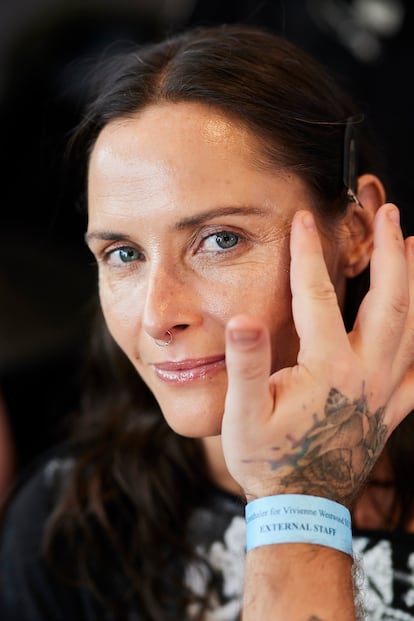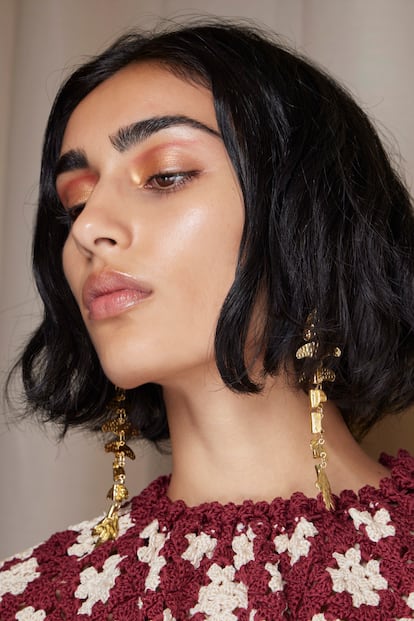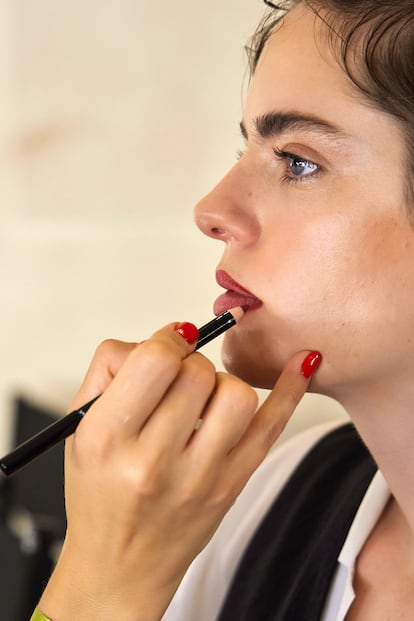What comes first, foundation or concealer? Makeup artists settle the debate
Does the order follow any logic, or is it more a matter of taste? Here’s all you need to know

Few things are as hypnotic as watching a professional makeup artist at work. It is a whole choreography with brushes, textures and colors that, even if it does not seem like it, follows a strict order when applying the different products. Although there are personal preferences, most begin with the skin, continue with the eyes and finish with the mouth. But is there a logic behind the order? Or is it exclusively a matter of taste?
The short answer is that every makeup artist has their own technique; when it comes to makeup, there is no right or wrong. However, there are some universal tips and tricks to ensure the best possible result. For this reason, experts recommend a generic pattern that we can adapt, to a greater or lesser extent, to our routine. And although the best way to find the one that works for you is by trial and error, the professional makeup artists consulted share all their experience to help you find the perfect order.
Is primer really necessary?
When do we want this reinforcement in our makeup routine? The matter might raise some doubts, but it always depends on each person’s specific needs. For Xabier Rodrigues, National Artist at MAC Cosmetics, “primer helps to set the base, and it is normally used in special makeup in which durability is a priority, such as the case of brides. If the complexion is very dry, I don’t usually apply it, because makeup lasts a long time in this type of skin. For oily or porous skin, it is very useful because it smooths the texture and controls sebum production to prevent shine.”

Foundation… concealer… highlighter… which comes first?
As we said, the order is a subjective matter. Many makeup artists apply concealer under the foundation; others put it over it. First, it is important to be clear what each one is for. “There are several types of concealers: some for the area with dark circles and others to neutralize different tones on the face, such as blemishes, marks, pimples or redness. But if we want to make the darkest parts of the face lighter, then we can use a matte highlighter, which is usually a lighter tone than our skin,” says Sephora Pro Makeup Artist Verónica Pose.
How to apply them correctly? “I first apply the concealer, blending it well towards the cheekbones, so that it blends in and there are no visible lines. Afterwards I spread the foundation, going over the concealer a bit and blending it so that there are no visible edges. Finally, we apply the matte highlighter to the cheekbones, the upper part of the nose, the Cupid’s bow and the chin,” says Rodrigues.
Defining the eyebrows
Once the skin is ready, it is time to continue with the eyebrows. Defining them before moving on to eye makeup is important because they frame the face, define the expression and help us not to go too far with things like the tone of the eye shadow. “For a natural finish, the best is to apply a little pencil on the areas that have no hair, drawing them subtly to give them some volume and definition and, finally, set them with gel,” suggests Rodrigues.

Eye shadow, eyeliner and mascara
Many professionals start their makeup routine with the eye shadow, especially when they want a dramatic, dark, smoky effect. This premise is based on the fact that you can later clean any residue that falls on your face before applying the foundation. However, even though this theory has a solid basis, most experts prefer to start with the skin when they do daytime makeup. To know the best order to apply eye makeup, Rodrigues explains, “the shadows go first, then the eyeliner. If we do it the other way around, the shadows can fall on the liner and reduce the intensity of the color, or worse, we could smudge the line. To apply the shadow, it is best to have three tools: a compact brush to apply the color with intensity, a blending brush and another, pen-shaped one, to create certain shapes. The eyeliner is applied following the beginning of the eyelashes, thickening the stroke a little on the outer half of the eye to lift the gaze. Beginners should start with a thin line along the upper lashes.”

Blush and highlighter
The blush provides a healthy tone and the highlighter a subtle glow. “I like to apply the highlighter first and then blend it with the blush. If you want a glowy spot, one of my favorite effects is to mix a drop of liquid blush with a drop of highlighter. A very special trick for when you want a particularly subtle effect is to apply the liquid blush before the makeup base, so that it seems that the color comes from inside the skin,” says Gisela Bosque, National Makeup Artist at Sephora.

Lips
Lips come at the end of every expert’s makeup routine. “I love to finish with the lips, but before applying any makeup I hydrate them with a specific balm at the beginning, just when we are preparing the skin. The trick to make them look good is to start by tracing their shape with a liner pencil the same shade as the lipstick, and then use the stick. My advice is to start with the Cupid’s bow, doing the same movement from one side to the other to achieve symmetry in both the upper and lower lip,” says Pose.

Setting powder or spray?
Regardless of the order you choose when applying the products, there is always one final goal: to ensure that the result remains intact for a long time. That is what setting powders and sprays are for. What is the difference? “In oily skin, powders help set fluid or creamy products. I like to apply them on the sides of the nose, brow, nasolabial folds and chin, which are the areas with more sebum production and shine. The spray is also a great ally for setting makeup; the best is to apply it after the powder, to blend it into the skin. On a dry complexion I would only use the spray, but if we are using very oily products, a little powder doesn’t hurt, either. Balance is the key,” concludes Rodrigues.

Sign up for our weekly newsletter to get more English-language news coverage from EL PAÍS USA Edition
Tu suscripción se está usando en otro dispositivo
¿Quieres añadir otro usuario a tu suscripción?
Si continúas leyendo en este dispositivo, no se podrá leer en el otro.
FlechaTu suscripción se está usando en otro dispositivo y solo puedes acceder a EL PAÍS desde un dispositivo a la vez.
Si quieres compartir tu cuenta, cambia tu suscripción a la modalidad Premium, así podrás añadir otro usuario. Cada uno accederá con su propia cuenta de email, lo que os permitirá personalizar vuestra experiencia en EL PAÍS.
¿Tienes una suscripción de empresa? Accede aquí para contratar más cuentas.
En el caso de no saber quién está usando tu cuenta, te recomendamos cambiar tu contraseña aquí.
Si decides continuar compartiendo tu cuenta, este mensaje se mostrará en tu dispositivo y en el de la otra persona que está usando tu cuenta de forma indefinida, afectando a tu experiencia de lectura. Puedes consultar aquí los términos y condiciones de la suscripción digital.
More information
Últimas noticias
Most viewed
- Sinaloa Cartel war is taking its toll on Los Chapitos
- Oona Chaplin: ‘I told James Cameron that I was living in a treehouse and starting a permaculture project with a friend’
- Reinhard Genzel, Nobel laureate in physics: ‘One-minute videos will never give you the truth’
- Why the price of coffee has skyrocketed: from Brazilian plantations to specialty coffee houses
- Silver prices are going crazy: This is what’s fueling the rally










































